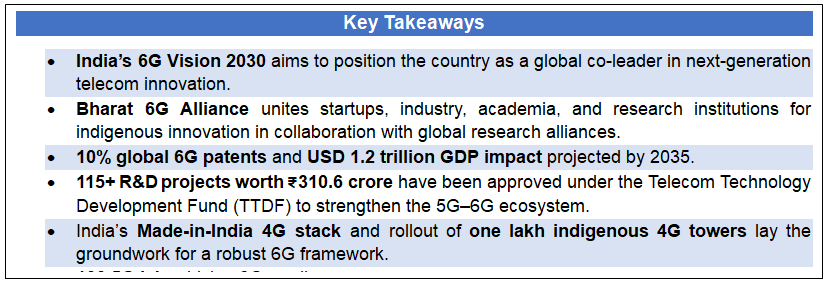
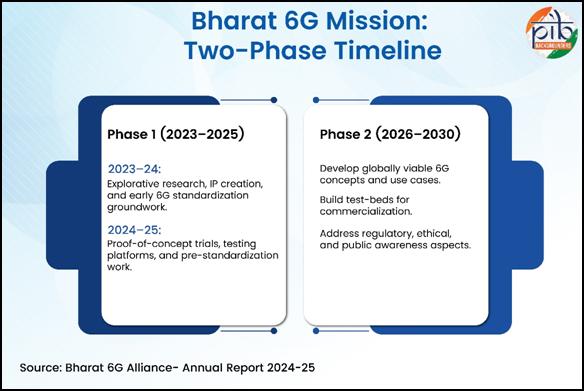
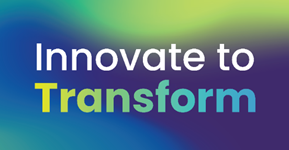
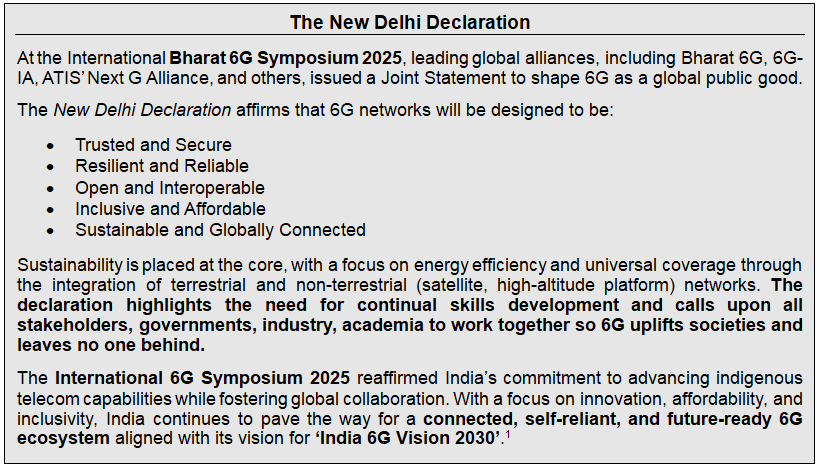
PIB Headquarters

Building a Viksit Bharat with 6G
From 4G Self-Reliance to 6G Global Leadership
Posted On: 26 OCT 2025 2:07PM by PIB Delhi

Introduction
The Government of India is steering the nation’s transition towards next-generation connectivity through a series of strategic initiatives aimed at advancing 6G technologies. Anchored in the principles of affordability, sustainability, and ubiquity, India’s 6G vision focuses on empowering society through indigenous innovation, advanced R&D, and global collaboration. With active participation from industry, academia, and research institutions, India is positioning itself as a global hub for future telecom technologies, aligned with the broader national goal of building a Viksit Bharat by 2047.
What is 6G?
6G, or sixth-generation wireless technology, will succeed 5G and make internet connections significantly faster and smoother. It will use higher radio frequencies than 5G, letting it handle vast data at once with almost no delay.
6G aims to send and receive information in just one microsecond, that’s 1,000 times faster than the response time of 5G. This means instant connections with almost zero lag, which will be useful for things like remote medical surgeries, smart robotics, and real-time gaming.
The 6G network will also improve features like advanced imaging, precise location tracking, and creating lifelike virtual experiences. When combined with artificial intelligence (AI), it will be smart enough to decide automatically where to store, process, and share data, making technology more efficient and responsive everywhere.
India’s 6G Vision: Positioning India as a Global Telecom Innovator
The Bharat 6G Vision manifesto aims to make India a leading supplier of advanced telecom technologies, aligned with Viksit Bharat objectives. The rapid rollout and domestic adoption of 5G is laying the foundation for India’s 6G vision, positioning the country as a global leader in future telecom innovation. 6G Vision is based on principles of affordability, sustainability, and ubiquity.
On March 22, 2023, the “Bharat 6G Vision” document was released, envisioning India as a frontline contributor in the design, development, and deployment of 6G technology by 2030. The Government has taken following initiatives to facilitate the development of 6G technology in the country:
- Funding two testbeds namely 6G THz Testbed & Advance Optical Communication Testbed to promote R&D and innovation in the country.
- Sanctioned 100 5G labs at academic institutions in FY 2023- 24, across India for capacity building & for building a 6G ready academic and start-up ecosystem in the country.
- 104 research proposals have been approved on 6G network ecosystems to promote research and innovation in line with global roadmap for 6G technology.
Bharat 6G Alliance
The Bharat 6G Alliance (B6GA) is an initiative of Indian industry, Telecom Service providers, academia, national research institutions, and standards organizations. Supported by the government and industry, it drives indigenous 6G research and development to create a self-reliant, globally competitive ecosystem for advanced communications technologies. With state-of-the-art labs and innovation focus on multi-chip modules, SoCs, and advanced IoT applications, India aims to lead the global 6G movement. B6GA is an industry-led body, facilitated by the government, providing a collaborative platform to technology stakeholders including public/private companies, academia, research institutions, and standard development organizations. Bharat 6G Alliance has constituted seven Working Groups on different domains of 6G like Spectrum, Technology, Applications, Green and Sustainability and use cases.
In a step towards redefining the future of global communication, the Bharat 6G Alliance signed a Memorandum of Understanding (MoU) with leading research alliances like the NextG Alliance (USA), 6G IA (Europe), 6G Flagship Oulu University (Finland) 6G Forum South Korea, XGMF Japan, NGMN Alliance, 5G ACIA, UKI FNI, UK TIN, European Space Agency (ESA) and 6G Brasil (Brazil) to collaborative research and standardization. It has MOU with TSDSI and NASSCOM to utilise national synergy. These MoUs with 6G research alliances will further enable development of secure and trusted telecommunication technology including resilient supply chains.
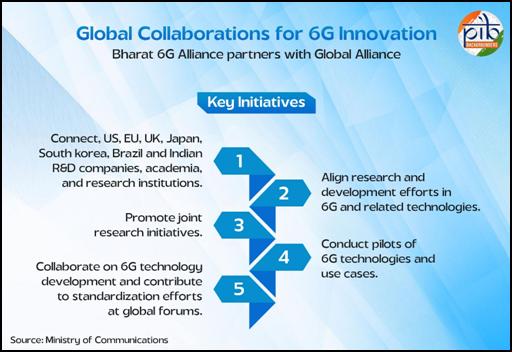
Bharat’s 6G Mission
India’s pursuit of 6G began with an ambitious vision to become a global leader in next-generation wireless communications. This vision has driven the emergence of a dynamic ecosystem of innovators, researchers, startups, and policymakers, all dedicated to advancing connectivity. As the mission progresses into its next phase, the focus is on scaling past achievements, deepening technological innovation, and ensuring that 6G not only benefits India but originates here. Through collaboration and shared purpose, India is paving the way for leadership in the global digital future.

Spotlight on India @ India Mobile Congress, 2025
 The International 6G Symposium 2025, held during the India Mobile Congress (IMC) 2025, marked a significant milestone in India’s journey towards next-generation communication technologies. The event highlighted the nation’s growing strength in telecom innovation, indigenous R&D, and global digital leadership.
The International 6G Symposium 2025, held during the India Mobile Congress (IMC) 2025, marked a significant milestone in India’s journey towards next-generation communication technologies. The event highlighted the nation’s growing strength in telecom innovation, indigenous R&D, and global digital leadership.
Advancing India’s Technological Self-Reliance
India’s Made-in-India 4G stack was showcased as a landmark achievement in the country’s drive toward technological self-reliance and export readiness. This indigenous development forms the foundation of the ‘India 6G Vision 2030’, aimed at creating future-ready, secure, and scalable telecom networks.
India’s 6G roadmap envisions the sector contributing nearly USD 1.2 trillion to the national GDP by 2035. The country is targeting 10% of global 6G patents, underscoring its emergence as a hub for innovation in telecom technologies. In parallel, the satellite communications market is projected to triple by 2033, strengthening India’s space-linked connectivity ecosystem.
Focus on Collaboration and Inclusivity
 The symposium called for greater international cooperation, indigenous R&D, and synergy between academia, industry, and governments to shape an inclusive and affordable global 6G framework. Emphasis was placed on building a swadeshi telecom ecosystem, supported by recent advances such as the nationwide rollout of one lakh indigenous 4G towers, a crucial step towards developing a resilient infrastructure for next-generation networks.
The symposium called for greater international cooperation, indigenous R&D, and synergy between academia, industry, and governments to shape an inclusive and affordable global 6G framework. Emphasis was placed on building a swadeshi telecom ecosystem, supported by recent advances such as the nationwide rollout of one lakh indigenous 4G towers, a crucial step towards developing a resilient infrastructure for next-generation networks.
The guiding vision emphasized that India is moving beyond being a consumer of technology to becoming a co-creator and co-leader in the 6G revolution, shaping the future of communication for both domestic and global needs.
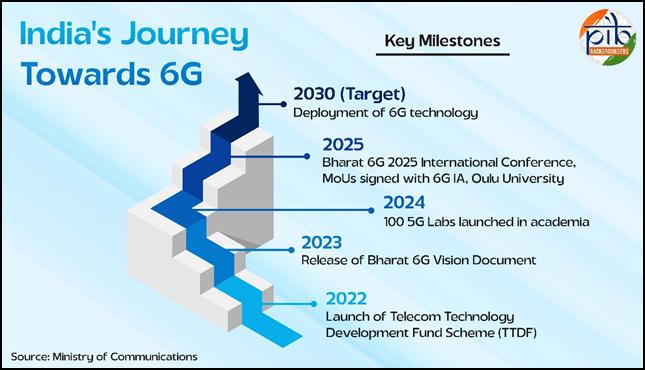
Key Announcements and Releases
The event featured several important outcomes aimed at accelerating India’s 6G readiness:
- A Joint Declaration on 6G Principles was released on October 10, 2025.
- The Bharat 6G Alliance signed two Memoranda of Understanding (MoUs): one with NASSCOM and another with the European Space Agency to promote collaborative research and innovation in 6G and allied technologies.
- The Bharat 6G Alliance also unveiled four whitepapers, providing strategic direction for the sector:
- Spectrum Roadmap for 6G in India
- Powering Next-Gen Telecom
- AI and Network Evolution to 5G
- 6G Architecture, Security and Exposure Framework for RF Sensing

Government Initiatives for a Future-Ready 6G Telecom Ecosystem
India is advancing towards a 6G-ready ecosystem through initiatives that boost innovation, collaboration, and skills in next-gen telecom. These efforts focus on indigenous research, industry–academia partnerships, and startup support to enable cutting-edge solutions.
- 100 5G Labs Across Academic Institutions: Building a 6G-Ready Innovation Ecosystem
To foster skills, research, and experimentation in advanced telecom technologies, the Government of India has established 100 5G labs across academic institutions nationwide. The key objectives include:
- To build competencies and engagement in 5G technologies in students and academic fraternity.
- To enable projects at UG and PG level for students using 5G environment.
- To encourage academia-industry engagement to ideate and develop 5G use cases.
- To provide local access to 5G test setup for Startups and MSMEs around the institution.
- Making Indian academia & Startup ecosystem 6G ready.
- Telecom Technology Development Fund (TTDF): Driving Indigenous R&D in Telecom
Launched on 1st October 2022, the Telecom Technology Development Fund (TTDF) scheme aims to accelerate innovation and R&D in telecom, including 6G technologies.
Key highlights:
- The Telecom Technology Development Fund Scheme has been notified for domestic companies and institutions involved in technology design, development, commercialization of telecommunication products and solutions to enable affordable broadband and mobile services in rural and remote areas.
- The scheme aims to fund Research and Development (R&D) and innovation in telecom technologies, fostering collaboration between academia, start-ups, MSMEs, research institutes, and industry to enhance the telecom ecosystem in India.
- A total 115 projects related to 5G and 6G amounting to Rs. 310.6 Crores have been approved under TTDF scheme as of 30th September, 2025. The duration of these R&D projects ranges from 1 to 5 years. These projects are currently in the initial stages of development.
- Bharat 6G Alliance: A Unified National Effort for Global 6G Leadership
To advance the Bharat 6G Vision, India launched the Bharat 6G Alliance, bringing together industry, academia, startups, research institutions, and standardization bodies. The alliance is focused on enabling indigenous innovation and driving global collaboration.
- As of July 2025, the alliance comprises 80+ member organizations, including 30+ startups.
- Signed multiple MoUs with international 6G alliances to foster global knowledge exchange and joint development
- Aim to provide ubiquitous, intelligent, and secure connectivity for high-quality living experience for the world.
- Aims to bridge rural-urban divides and enable global digital inclusion.
- Ideation phase for proof-of-concept, followed by deployment of technology solutions for India and the global community.
- Technology Innovation Hub at IIIT-B: Pioneering 6G-Ready Technologies
Under the National Mission on Interdisciplinary Cyber-Physical Systems (NM-ICPS), a Technology Innovation Hub has been established at IIIT Bangalore, with a focus on Advanced Communication Systems that will shape future 6G networks.
- The hub is dedicated to Advanced Communication Systems, addressing both current and future national needs and international trends.
- Development of Reconfigurable Intelligent Surfaces and O-RAN Massive MIMO to enhance coverage, capacity, and sensing.
- Core focus areas include designing and developing technology building blocks for 5G–advanced (5G+) and 6G systems and networks.
- Priority is given to indigenous research that leads to creation of intellectual property (IP), such as product IP for commercial applications.
- Emphasis on generating patents (IPR) to drive product-based innovation and facilitate incorporation into upcoming 5G-advanced and 6G standards.
Together, these initiatives are shaping a secure, inclusive, and future-proof digital infrastructure that not only strengthens India’s leadership in the global 6G race but also promotes equitable access to information, connectivity, and services for all. By empowering startups, nurturing talent, and deepening global partnerships, India is laying the groundwork for a connected, self-reliant, and digitally inclusive future.
Conclusion
India’s pursuit of next-generation telecom technologies is guided by a vision of self-reliance, innovation, and global collaboration. The discussions and announcements at the International Bharat 6G Symposium 2025 reaffirmed the nation’s commitment to developing a secure, inclusive, and future-ready digital ecosystem. Through initiatives such as the Bharat 6G Alliance, the Telecom Technology Development Fund, and active partnerships with global research institutions, India is steadily transitioning from being a technology adopter to a technology creator and standard-setter.
These strategic initiatives not only strengthen the domestic telecom ecosystem but also position India as a key contributor to the global 6G framework. The continued emphasis on affordability, sustainability, and ubiquity will ensure that India’s technological progress benefits every section of society while supporting the country’s vision of Viksit Bharat by 2047.
References
TechTarget: https://www.techtarget.com/searchnetworking/definition/6G
Ministry of Communications:
Bharat 6G Alliance:
· https://bharat6galliance.com/bharat6G/public/assets/report/document_79664556.pdf
· https://bharat6galliance.com/bharat6G/public/assets/report/B6GA-Annual-Report-2024-25.pdf
Department of Science and Technology: https://comet.iiitb.ac.in/wp-content/uploads/2024/10/IIITB-COMET-Brochure-3.pdf
***
SK | SA
(Release ID: 2182603)
Source link


